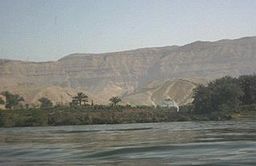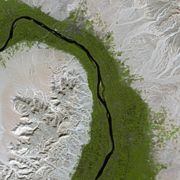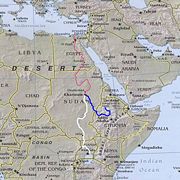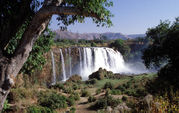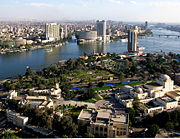Nile
2008/9 Schools Wikipedia Selection. Related subjects: African Geography
| Nile | |
| River | |
|
The River in Egypt
|
|
| Name origin: "Nile"(Arabic: 'nīl) comes from the Greek word Neilos (Νειλος) | |
| Countries | |
|---|---|
| Cities | Khartoum, Cairo |
| Primary source | White Nile |
| - coordinates | |
| Secondary source | Blue Nile |
| - location | Lake Tana, Ethiopia |
| - coordinates | |
| Source confluence | near Khartoum |
| Mouth | |
| - location | Mediterranean Sea |
| Length | 6,650 km (4,132 mi) |
| Basin | 3,400,000 km² (1,312,747 sq mi) |
| Discharge | |
| - average | 2,830 m³/ s (99,941 cu ft/ s) |
The Nile (Arabic: النيل, transliteration: an-nīl, Ancient Egyptian iteru or Ḥ'pī, Coptic piaro or phiaro) is a major north-flowing river in Africa, generally regarded as the longest river in the world.
The Nile has two major tributaries, the White Nile and Blue Nile, the latter being the source of most of the Nile's water and fertile soil, but the former being the longer of the two. The White Nile rises in the Great Lakes region of central Africa, with the most distant source in southern Rwanda , and flows north from there through Tanzania, Lake Victoria, Uganda and southern Sudan, while the Blue Nile starts at Lake Tana in Ethiopia , flowing into Sudan from the southeast. The two rivers meet near the Sudanese capital Khartoum.
The northern section of the river flows almost entirely through desert, from Sudan into Egypt, a country whose civilization has depended on the river since ancient times. Most of the population of Egypt and all of its cities, with the exception of those near the coast, lie along those parts of the Nile valley north of Aswan; and nearly all the cultural and historical sites of Ancient Egypt are found along the banks of the river. The Nile ends in a large delta that empties into the Mediterranean Sea.
Etymology of the word Nile
The word "Nile"(Arabic: 'nīl) comes from Greek Neilos (Νειλος), meaning river valley, and likely borrowed from Phoenician. In the ancient Egyptian language, the Nile is called Ḥ'pī or iteru, meaning "great river", represented by the hieroglyphs shown on the right (literally itrw). In Coptic, the words piaro (Sahidic) or phiaro (Bohairic) meaning "the river" (lit. p(h).iar-o "the.canal-great") come from the same ancient name.
Tributaries and distributaries
The drainage basin of the Nile covers 3,254,555 square kilometres (1,256,591 sq mi), about 10% of the area of Africa.
There are two great tributaries of the Nile, joining at Khartoum: the White Nile, starting in equatorial East Africa, and the Blue Nile, beginning in Ethiopia. Both branches are on the western flanks of the East African Rift, the southern part of the Great Rift Valley. Below the Blue and White Nile confluence the only remaining major tributary is the Atbara River, which originates in Ethiopia north of Lake Tana, and is around 800 kilometres (500 mi) long. It flows only while there is rain in Ethiopia and dries very fast. It joins the Nile approximately 300 kilometres (200 mi) north of Khartoum.
The Nile is unusual in that its last tributary (the Atbara) joins it roughly halfway to the sea. From that point north, the Nile diminishes because of evaporation.
The course of the Nile in Sudan is distinctive. It flows over 6 groups of cataracts, from the first at Aswan to the sixth at Sabaloka (just north of Khartoum) and then turns to flow southward for a good portion of its course, before again returning to flow north to the sea. This is called the "Great Bend of the Nile."
North of Cairo, the Nile splits into two branches (or distributaries) that feed the Mediterranean: the Rosetta Branch to the west and the Damietta to the east, forming the Nile Delta.
White Nile
The source of the Nile is sometimes considered to be Lake Victoria, but the lake itself has feeder rivers of considerable size. The most distant stream—and thus the ultimate source of the Nile—emerges from Nyungwe Forest in Rwanda, via the Rukarara, Mwogo, Nyabarongo and Kagera rivers, before flowing into Lake Victoria in Tanzania near the town of Bukoba.
The Nile leaves Lake Victoria at Ripon Falls near Jinja, Uganda, as the Victoria Nile. It flows for approximately 500 kilometres (300 mi) farther, through Lake Kyoga, until it reaches Lake Albert. After leaving Lake Albert, the river is known as the Albert Nile. It then flows into Sudan, where it becomes known as the Bahr al Jabal ("River of the Mountain"). The Bahr al Ghazal, itself 716 kilometres (445 mi) long, joins the Bahr al Jabal at a small lagoon called Lake No, after which the Nile becomes known as the Bahr al Abyad, or the White Nile, from the whitish clay suspended in its waters. When the Nile flooded it left this rich material named silt. The Ancient Egyptians used this soil to farm. From Lake No, the river flows to Khartoum. An anabranch river called Bahr el Zeraf flows out of the Nile's Bahr al Jabal section and rejoins the White Nile.
The term "White Nile" is used in both a general sense, referring to the entire river above Khartoum, and a limited sense, the section between Lake No and Khartoum.
Blue Nile
The Blue Nile ( Ge'ez ጥቁር ዓባይ Ṭiqūr ʿĀbbāy (Black Abay) to Ethiopians; Bahr al Azraq to Sudanese) springs from Lake Tana in the Ethiopian Highlands. The Blue Nile flows about 1,400 kilometres (870 mi) to Khartoum, where the Blue Nile and White Nile join to form the "Nile proper". 90% of the water and 96% of the transported sediment carried by the Nile originates in Ethiopia, with 59% of the water from the Blue Nile alone (the rest being from the Tekezé, Atbarah, Sobat, and small tributaries). The erosion and transportation of silt only occurs during the Ethiopian rainy season in the summer, however, when rainfall is especially high on the Ethiopian Plateau; the rest of the year, the great rivers draining Ethiopia into the Nile (Sobat, Blue Nile, Tekezé, and Atbarah) flow weakly.
Lost headwaters
Formerly Lake Tanganyika drained northwards along the African Rift Valley into the Albert Nile, making the Nile about 900 miles (1,400 km) longer, until blocked in Miocene times by the bulk of the Virunga Volcanoes. See List of rivers by length.
Politics
The usage of the Nile River has been vastly associated with East and horn of African politics for many decades. Various countries, including Uganda, Sudan, Ethiopia and Kenya have complained about the Egyptian domination of the Nile water resources. The Nile Basin Initiative was one of the most important programs to promote equal usage and peaceful cooperation between the "Nile Basin States." Yet many fear, the Egyptian domination of the waters still causes massive economic obstacles in the area.
The Nile still supports much of the population living along its banks, with the Egyptians living in otherwise inhospitable regions of the Sahara. The river flooded every summer, depositing fertile silt on the plains. The flow of the river is disturbed at several points by cataracts, which are sections of faster-flowing water with many small islands, shallow water, and rocks, forming an obstacle to navigation by boats. The Sudd wetlands in Sudan also forms a formidable obstacle for navigation and flow of water, to the extent that Sudan had once attempted to dig a canal (the Jonglei Canal) to bypass this stagnant mass of water.
The Nile was, and still is, used to transport goods to different places along its long path; especially since winter winds in this area blow up river, the ships could travel up with no work by using the sail, and down using the flow of the river. While most Egyptians still live in the Nile valley, the construction of the Aswan High Dam (finished in 1970) to provide hydroelectricity ended the summer floods and their renewal of the fertile soil.
Cities on the Nile include Khartoum, Aswan, Luxor ( Thebes), and the Giza – Cairo conurbation. The first cataract, the closest to the mouth of the river, is at Aswan to the north of the Aswan Dams. The Nile north of Aswan is a regular tourist route, with cruise ships and traditional wooden sailing boats known as feluccas. In addition, many "floating hotel" cruise boats ply the route between Luxor and Aswan, stopping in at Edfu and Kom Ombo along the way. It used to be possible to sail on these boats all the way from Cairo to Aswan, but security concerns have shut down the northernmost portion for many years.
More recently, drought during the 1980s led to widespread starvation in Ethiopia and Sudan but Egypt was protected from drought by water impounded in Lake Nasser. Beginning in the 1980s techniques of analysis using hydrology transport models have been used in the Nile to analyze water quality.
Hydrology
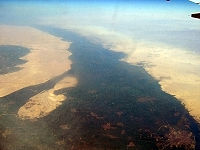
The flow rate of the Albert Nile at Mongalla is almost constant throughout the year and averages 1,048 m³/s (37,000 cu ft/s). After Mongalla, the Nile is known as the Bahr El Jebel which enters the enormous swamps of the Sudd region of Sudan. More than half of the Nile’s water is lost in this swamp to evaporation and transpiration. The average flow rate in the Bahr El Jebel at the tails of the swamps is about 510 m³/s (18,000 cu ft/s). From here it soon meets with the Sobat River and forms the White Nile.
The Bahr al Ghazal and the Sobat River are the two most important tributaries of the White Nile in terms of drainage area and discharge. The Bahr al Ghazal's drainage basin is the largest of any of the Nile's sub-basins, measuring 520,000 square kilometres (200,000 sq mi) in size, but it contributes a relatively small amount of water, about 2 m³/s (71 cu ft/s) annually, due to tremendous volumes of water being lost in the Sudd wetlands. The Sobat River, which joins the Nile a short distance below Lake No, drains about half as much land, 225,000 km² (86,900 sq mi), but contributes 412 cubic metres per second (14,500 cu ft/s) annually to the Nile. When in flood the Sobat carries a large amount of sediment, adding greatly to the White Nile's colour.
The average flow of the White Nile at Malakal, just below the Sobat River, is 924 m³/s (32,600 cu ft/s), the peak flow is approximately 1,218 m³/s (43,000 cu ft/s) in early March and minimum flow is about 609 m³/s (21,500 cu ft/s) in late August. The fluctuation there is due the substantial variation in the flow of the Sobat which has a minimum flow of about 99 m³/s (3,500 cu ft/s) in August and a peak flow of over 680 m³/s (24,000 cu ft/s) in early March.
From here the White Nile flows to Khartoum where it merges with the Blue Nile to form the Nile River. Further downstream the Atbara River, the last significant Nile tributary, merges with the Nile. During the dry season (January to June) the White Nile contributes between 70% and 90% of the total discharge from the Nile. During this period of time the natural discharge of the Blue Nile can be as low as 113 m³/s (4,000 cu ft/s), although upstream dams regulate the flow of the river. During the dry period, there will typically be no flow from the Atbara River.
The Blue Nile contributes approximately 80-90% of the Nile River discharge. The flow of the Blue Nile varies considerably over its yearly cycle and is the main contribution to the large natural variation of the Nile flow. During the wet season the peak flow of the Blue Nile will often exceed 5,663 m³/s (200,000 cu ft/s) in latter August (variation by a factor of 50).
Before the placement of dams on the river the yearly discharge varied by a factor of 15 at Aswan. Peak flows of over 8,212 m³/s (290,000 cu ft/s) would occur during the later portions of August and early September and minimum flows of about 552 m³/s (19,500 cu ft/s) would occur during later April and early May. The Nile basin is complex, and because of this, the discharge at any given point along the mainstem depends on many factors including weather, diversions, evaporation/ evapotranspiration, and groundwater flow.
History
The Nile (iteru in Ancient Egyptian) was the lifeline of the ancient Egyptian civilization, with most of the population and all of the cities of Egypt resting along those parts of the Nile valley lying north of Aswan. The Nile has been the lifeline for Egyptian culture since the Stone Age. Climate change, or perhaps overgrazing, desiccated the pastoral lands of Egypt to form the Sahara desert, possibly as long ago as 8000 BC, and the inhabitants then presumably migrated to the river, where they developed a settled agricultural economy and a more centralized society.
The river Nile froze twice in recorded history, in 829 and 1010.
The Eonile
The present Nile is at least the fifth river that has flowed north from the Ethiopian Highlands. Satellite imagery was used to identify dry watercourses in the desert to the west of the Nile. An Eonile canyon, now filled by surface drift, represents an ancestral Nile called the Eonile that flowed during the later Miocene (23–5.3 million years before the present). The Eonile transported clastic sediments to the Mediterranean, where several gas fields have been discovered within these sediments.
During the late-Miocene Messinian Salinity Crisis, when the Mediterranean Sea was a closed basin and evaporated empty or nearly so, the Nile cut its course down to the new base level until it was several hundred feet below world ocean level at Aswan and 8,000 feet (2,400 m) below Cairo. This huge canyon is now full of later sediment.
Lake Tanganyika drained northwards into the Nile until the Virunga Volcanoes blocked its course in Rwanda. That would have made the Nile much longer, with its longest headwaters in northern Zambia.
The integrated Nile
There are two theories in relation to the age of the integrated Nile. The first one is that the integrated drainage of the Nile is of young age, that the Nile basin was formerly broken into series of separate basins, only the most northerly (the Proto Nile basin) feeding a river following the present course of the Nile in Egypt and in the far north of the Sudan. Said (1981) stresses the fact that Egypt itself supplied most of the waters of the Nile during the early part of its history. The other theory is that the drainage from Ethiopia via rivers equivalent to the Blue Nile and the Atbara/ Takazze flowed to the Mediterranean via the Egyptian Nile since well back into Tertiary times.
Salama (1987) suggested that during the Tertiary there were a series of separate closed continental basins, each basin occupying one of the major Sudanese Rift System: Mellut Rift, White Nile Rift, Blue Nile Rift, Atbara Rift and Sag El Naam Rift. The Mellut Rift Basin is nearly 12 km deep at its central part. This rift is possibly still active, with reported tectonic activity in its northern and southern boundaries. The Sudd swamps which forms the central part of the Basin is possibly still subsiding. The White Nile Rift System, although shallower than Bahr El Arab, is about 9 km deep. Geophysical exploration of the Blue Nile Rift System estimated the depth of the sediments to be 5–9 km. These basins were not interconnected except after their subsidence ceased and the rate of sediment deposition was enough to fill up the basins to such a level that would allow connection to take place. The filling up of the depressions led to the connection of the Egyptian Nile with the Sudanese Nile, which captures the Ethiopian and Equatorial head waters during the latest stages of tectonic activities of Eastern, Central and Sudanese Rift Systems. The connection of the different Niles occurred during the cyclic wet periods. The River Atbara overflowed its closed basin during the wet periods which occurred about 100,000 to 120,000 years B.P. The Blue Nile was connected to the main Nile during the 70,000–80,000 years B.P. wet period. The White Nile system in Bahr El Arab and White Nile Rifts remained a closed lake until the connection of the Victoria Nile some 12,500 years B.P.
Role in the founding of Egyptian civilization
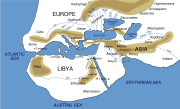
Sustenance played a crucial role in the founding of Egyptian civilization. The Nile is an unending source of sustenance. The Nile made the land surrounding it extremely fertile when it flooded or was inundated annually. The Egyptians were able to cultivate wheat and crops around the Nile, providing food for the general population. Also, the Nile’s water attracted game such as water buffalo; and after the Persians introduced them in the 7th century BC, camels. These animals could be killed for meat, or could be captured, tamed and used for ploughing — or in the camels' case, travelling. Water was vital to both people and livestock. The Nile was also a convenient and efficient way of transportation for people and goods.
The structure of Egypt’s society made it one of the most stable in history. In fact, it might easily have surpassed many modern societies. This stability was an immediate result of the Nile’s fertility. The Nile also provided flax for trade. Wheat was also traded, a crucial crop in the Middle East where famine was very common. This trading system secured the diplomatic relationship Egypt had with other countries, and often contributed to Egypt's economic stability. Also, the Nile provided the resources such as food or money, to quickly and efficiently raise an army for offensive or defensive roles.
The Nile played a major role in politics and social life. The pharaoh would supposedly flood the Nile, and in return for the life-giving water and crops, the peasants would cultivate the fertile soil and send a portion of the resources they had reaped to the Pharaoh. He or she would in turn use it for the well-being of Egyptian society.
The Nile was a source of spiritual dimension. The Nile was so significant to the lifestyle of the Egyptians, that they created a god dedicated to the welfare of the Nile’s annual inundation. The god’s name was Hapi, and both he and the pharaoh were thought to control the flooding of the Nile River. Also, the Nile was considered as a causeway from life to death and afterlife. The east was thought of as a place of birth and growth, and the west was considered the place of death, as the god Ra, the sun, underwent birth, death, and resurrection each time he crossed the sky. Thus, all tombs were located west of the Nile, because the Egyptians believed that in order to enter the afterlife, they must be buried on the side that symbolized death.
The Greek historian, Herodotus, wrote that ‘Egypt was the gift of the Nile’, and in a sense that is correct. Without the waters of the Nile River for irrigation, Egyptian civilization would probably have been short-lived. The Nile provided the elements that make a vigorous civilization, and contributed much to its lasting three thousand years.
That far-reaching trade has been carried on along the Nile since ancient times can be seen from the Ishango bone, possibly the earliest known indication of Ancient Egyptian multiplication, which was discovered along the headwaters of the Nile River (near Lake Edward, in northeastern Congo) and was carbon-dated to 20,000 BC.
Modern achievements
The White Nile Expedition, led by South African national Hendri Coetzee, became the first to navigate the Nile's entire length. The expedition took off from the source of the Nile in Uganda on January 17, 2004 and arrived safely at the Mediterranean in Rosetta, 4 months and 2 weeks later. National Geographic released a feature film about the expedition towards in late 2005 entitled The Longest River.
On April 28, 2004, geologist Pasquale Scaturro and his partner, kayaker and documentary filmmaker Gordon Brown became the first people to navigate the Blue Nile, from Lake Tana in Ethiopia to the beaches of Alexandria on the Mediterranean. Though their expedition included a number of others, Brown and Scaturro were the only ones to remain on the expedition for the entire journey. They chronicled their adventure with an IMAX camera and two handheld video cams, sharing their story in the IMAX film " Mystery of the Nile", and in a book of the same title. The team was forced to use outboard motors for most of their journey, and it was not until January 29, 2005 when Canadian Les Jickling and New Zealander Mark Tanner reached the Mediterranean Sea, that the river had been paddled for the first time under human power.
A team led by South Africans Peter Meredith and Hendri Coetzee on 30 April 2005, became the first to navigate the most remote headstream, the remote source of the Nile, the Akagera river, which starts as the Rukarara in Nyungwe forest in Rwanda.
On March 31, 2006, three explorers from Britain and New Zealand lead by Neil McGrigor claimed to have been the first to travel the river from its mouth to a new "true source" deep in Rwanda's Nyungwe rainforest. .
Crossings
This is a list of crossings from Khartoum to the Mediterranean:
- Aswan Bridge, Aswan
- Luxor Bridge, Luxor
- 1st Ring Road Bridge (Moneeb Crossing), Cairo
- Abbas Bridge, Cairo
- University Bridge, Cairo
- Qasr El Nile Bridge, Cairo
- 6th of October Bridge, Cairo
- Abu El Ela Bridge, Cairo
- 2nd Ring Road Bridge, Cairo
